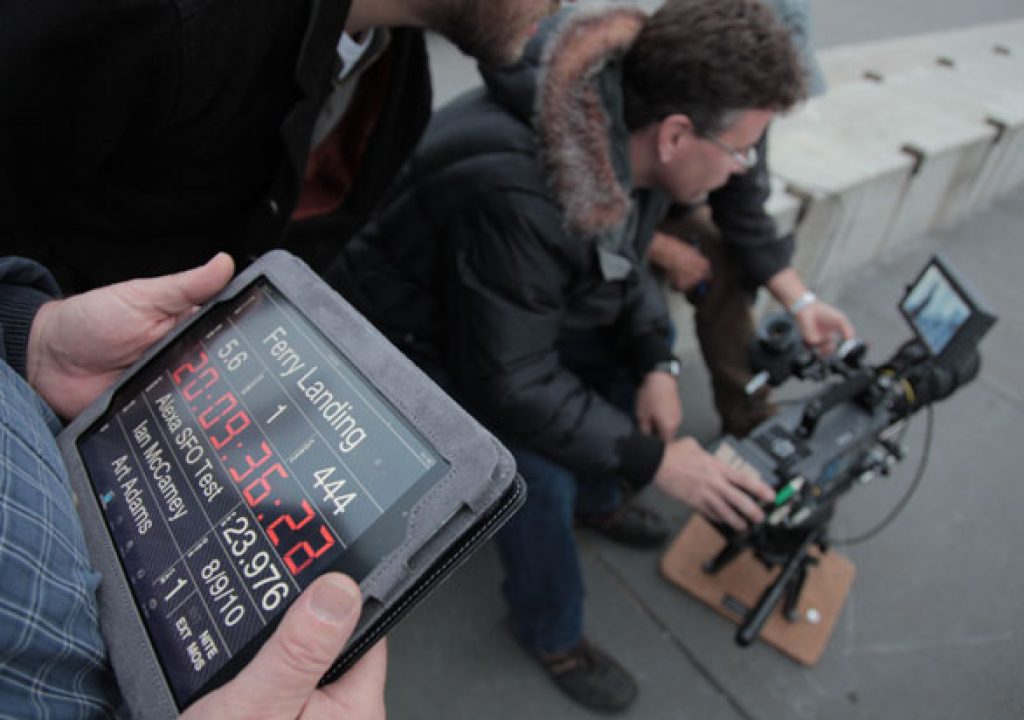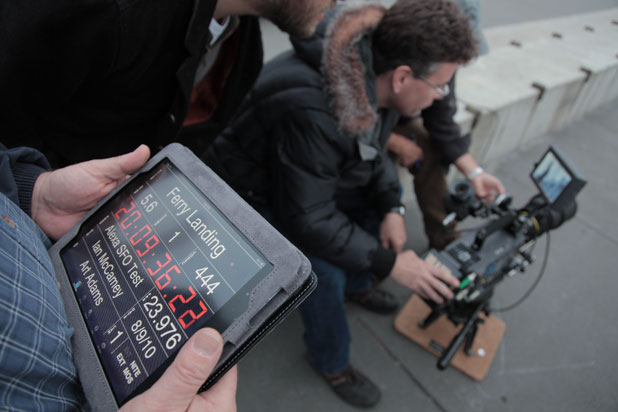
My dream HD camera records footage with log-encoded gamma to ProRes for a fast, easy and accessible post workflow and cost-effective color grading. It has the simplest control interface ever. It sees in the dark. And it’s built by a company whose gear I learned to trust early in my career when I started out as a camera assistant. The company is ARRI, and the camera is Alexa.
I was fortunate enough to have the chance to shoot with an Alexa prototype to produce demo footage for a recent meeting of the Northern California chapter of the Digital Cinema Society. Chapter president Simon Sommerfeld invited ARRI‘s Michael Bravin to present Alexa at the meeting, and Michael suggested shooting some scenics around San Francisco as a way of showing local folks how well the Alexa does under low light conditions. It fell to me to produce and shoot this content, and as I’m always looking for an opportunity to advance my reel I contacted director Ian McCamey, with whom I’ve shot numerous projects including Pink Martini, California State Fair and WEAVE, and asked him if he had any ideas as to how we could do more than just shoot pretty pictures.
As it turned out, he had a cunning plan. You’ll see more of that later after some additional editing and the creation of some visual effects. The important bit, though, was to be able to shoot on the night of Monday, August 3rd, and show an edited and graded montage Tuesday, August 4th, at the DCS meeting. Thanks to Alexa’s ProRes workflow we were able to do exactly that-and quite easily.
Joining Michael Bravin was Lucas Wilson of Assimilate, who gave probably the best Scratch demo possible: while Michael gave his Alexa introductory speech during the first half of the meeting, Lucas asked colorist Shane Mario Ruggieri to grade our LogC-encoded footage. By the dinner break we’d completely graded two minutes of LogC footage. Ian had cut the presentation on his laptop, which required him to downsample our recorded ProRes4444 to ProRes422 in order to play back the timeline at full speed. From Ian’s EDL Lucas linked back to the original LogC footage for the grade, Shane Mario worked his magic, and the graded footage was quickly married to the soundtrack for projected playback. We watched the finished and graded montage during the second half of the meeting.
Here it is:
But this story isn’t really about the meeting, but rather about the adventure leading up to the meeting. I gathered an intrepid band of regular DCS contributors, along with some of my regular crew, and we had some playtime with the camera along a scenic stretch of the San Francisco Bay. And along the way we learned quite a lot about the marvel that is Alexa. Turn the page for more…
All behind-the-scenes photographs are ©2010 by Adam Wilt. They are used by permission.
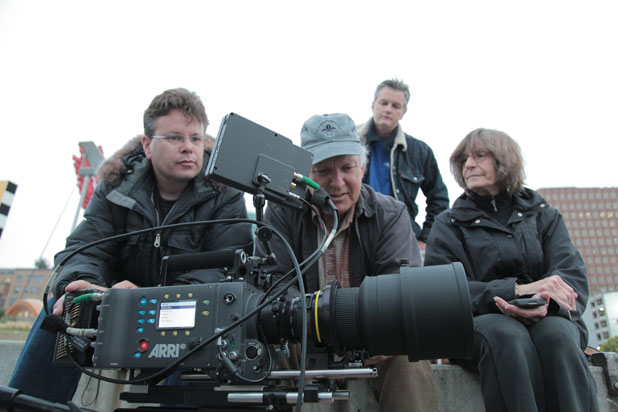
Left to right: Me, camera assistant Paul Marbury, gaffer/DCS chapter president Simon Sommerfeld, and Leigh Blicher, co-owner of Videofax.
My intrepid crew of volunteers included DCS chapter president Simon Sommerfeld as gaffer; camera assistant Paul Marbury; Adam Wilt as behind-the-scenes documentarian; and Jim Feeley as production assistant. Also accompanying us was Michael Bravin of ARRI and Leigh Blicher, co-owner of Videofax, who provided us with nearly all of our support gear. (Chater Camera supplied two lenses, but the rest of the gear came from Videofax.) Our talent was Colin Stuart, who appeared in both my WEAVE and Facebook projects.
Our goal: to shoot a mysterious man walking through San Francisco, surrounded by shapes that are, at first, completely unnoticeable; eventually the edges of the shapes start to glow and we realize that our character is constantly surrounded by them. The shapes will take on meaning after the visual effects are completed, and I won’t ruin that surprise until that project is competed. Ian and I scouted three locations, two of which we used: The Embarcadero, a street and promenade that winds its way along the east side of San Francisco, along the piers; and Treasure Island, a man-made island built by the military halfway between San Francisco and Oakland. Our third location, on Telegraph Hill, offered a spectacular view of the Transamerica Building. Unfortunately the fog was so heavy that night that the building was completely obscured, so we wrapped after shooting at Treasure Island.
Oh, and we shot entirely without permits. Which wasn’t hard as we basically looked like a news crew with a few more people and a couple of additional cases.
The entire piece was recorded to SxS cards in ProRes4444 and LogC. LogC is a Cineon-based log curve that captures everything the sensor has to offer and makes it available for grading. Log curves are not raw, but are actually more efficient than raw as storing raw linear data wastes quite a lot of space. Log gamma encoding captures more than enough information to stand up to very aggressive grading. (I hope to write an article in the near future specifically about ARRI’s LogC implementation.)
The camera was rated at EI 800, and the shutter varied between 180 and 270 degrees. The white balance was set to 3200k and never budged. The frame rate was 23.98p. I’m going to talk about the shots in the order that they appear in the montage, not in shooting order.
The first shot in the piece occurred well after dark, and not long before our move to Treasure Island around 10:30pm:
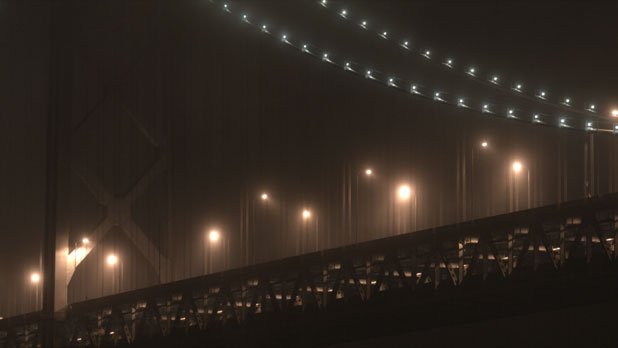
Close-up of the Bay Bridge from The Embarcadero near Harrison St. This was a grab shot on a 200mm Nikkor lens, shot wide open at T2. This is the graded version.
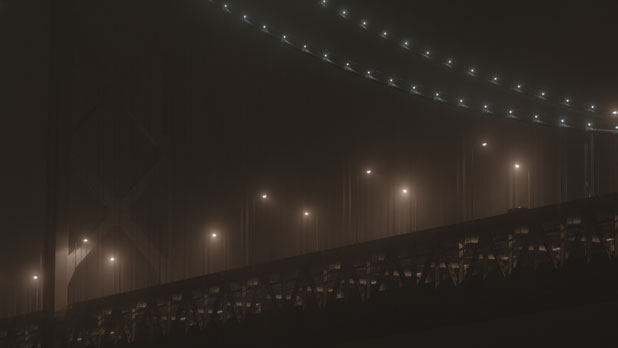
This is the same shot in LogC, ProRes4444, ungraded.
Just before our location move we grabbed a number of shots, including one where we shot through the window of a local restaurant. We just wanted to see what we could get. I didn’t bother with a meter reading as there was no point. At one point earlier in the evening the fog read T0.5 reflected. This was shot with a 270 degree shutter.
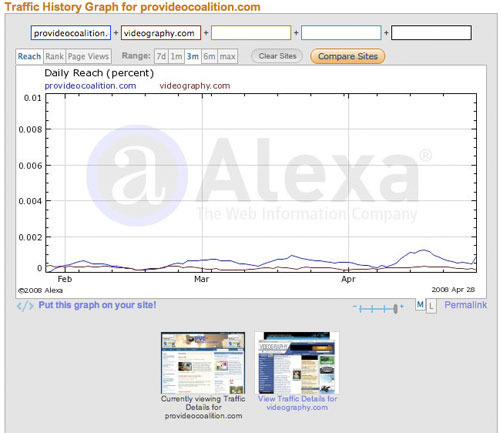
Talent Colin Stuart in front of the Bay Bridge. 85mm Super Speed, T1.3, 180 degree shutter. Bright side of face read T1.4 incident. Fill is from ambient street lighting. This is the graded version.
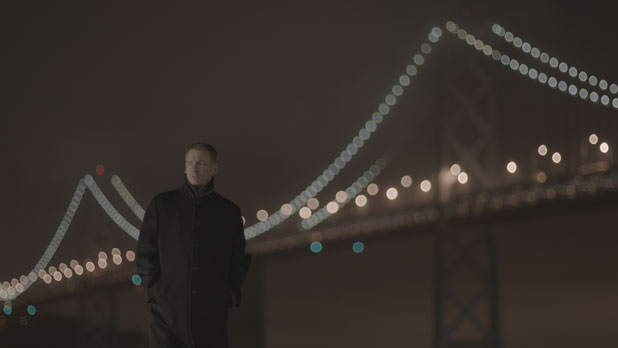
This is the same shot in LogC, ProRes4444, ungraded.
This was the first shot that we lit all evening:
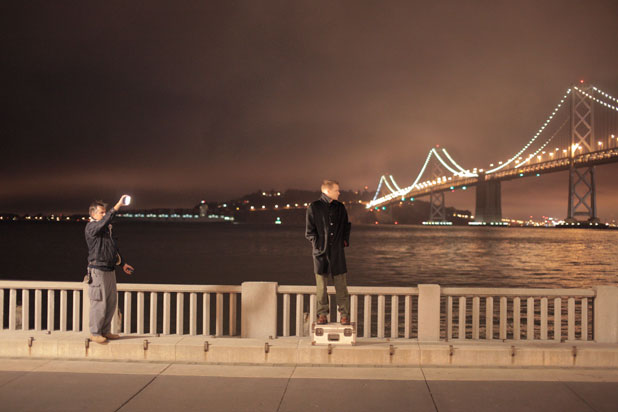
That’s gaffer Simon Sommerfeld holding a LightPanel Micro. Most of the light in the shot came from the left side of frame, so I asked Simon to pop up the frame left side of Colin’s face for a little more contrast. I’ve found great success in following the direction of the ambient light and enhancing it, rather than fighting it, and using the Micro from the left of frame hid the fact that it was a separate and additional source. It increased the contrast on Colin’s face by popping the existing highlights as the ambient streetlight tended to be a little flat.
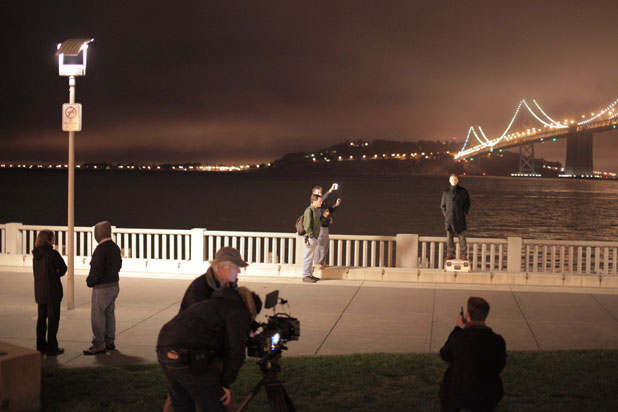
Left to right: Leigh Blicher and Michael Bravin observe while I look through the viewfinder, Paul Marbury pulls focus between Colin Stuart and the bridge, production assistant Jim Feeley conveys instructions to Colin via radio, Simon Sommerfeld holds the LightPanel Micro, Colin stands on a lens case for height, and Ian McCamey directs from near the camera position.
Around this time I took a few meter readings and discovered that the bright sky under the bridge, lit by the Port of Oakland in the far distance, read T0.7 5/10 and the fog over the bridge read T0.5 1/2. I was a bit baffled because everything looked brighter through the viewfinder, and on the on-camera monitor, than my meter said it should, but at some point I realized that the Alexa was showing me things my meter couldn’t even read.
This is a situation were a large HD monitor would have been very helpful. I couldn’t judge the quality and direction of the fill by eye as it was incredibly dim, and the small on-board monitor didn’t allow me to see a lot of detail. At T1.3 and EI 800 a good-sized monitor is necessary to see what kind of image you’re really capturing as the monitor will be brighter and crisper than what the eye can see on its own.
On a real production I would have flagged a certain amount of the fill off of the right side of Colin’s face for a more dramatic feel. My sense is that night/exterior cinematography with this camera will be more about the grips than the electricians: the crucial aspect of lighting will be removing the sources that you don’t want, and slightly enhancing the ones that you do. That’s not to say that an electrical crew won’t be necessary-far from it!-but we’ll be doing more with fewer lights and spending additional time removing sources rather than adding them.
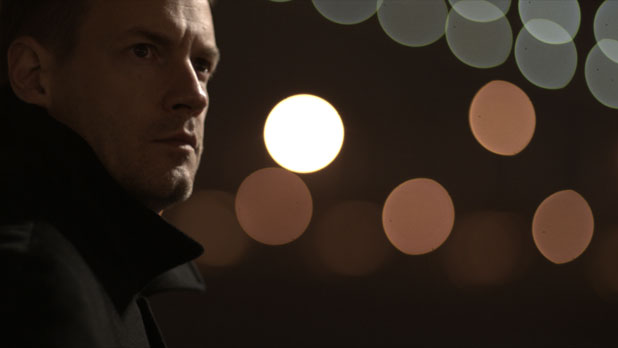
Handheld with an 85mm lens at T1.3, 270 degree shutter, pulling my own focus.
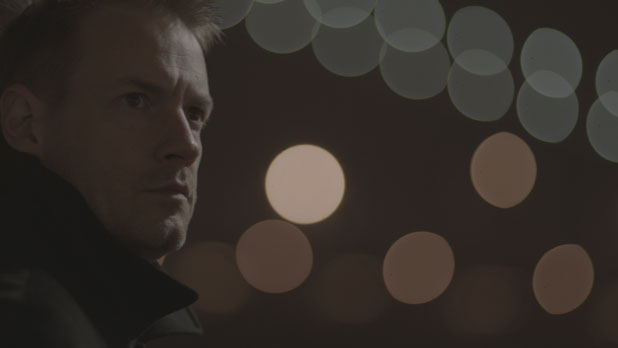
This is the same shot in LogC, ProRes4444, ungraded.
I’m going to group this shot with a couple of others that we shot around the same time:
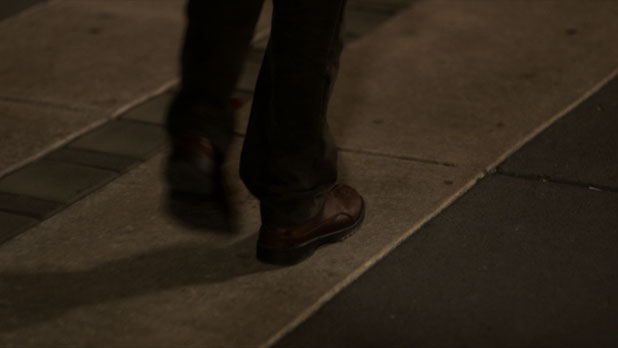
Handheld, 85mm lens at T1.3, 270 degree shutter, pulling my own focus.
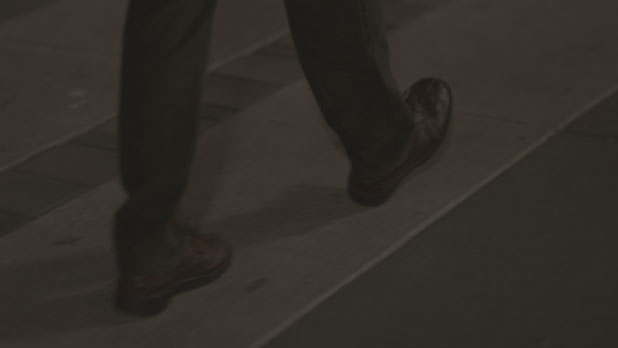
This is the same shot in LogC, ProRes4444, ungraded.
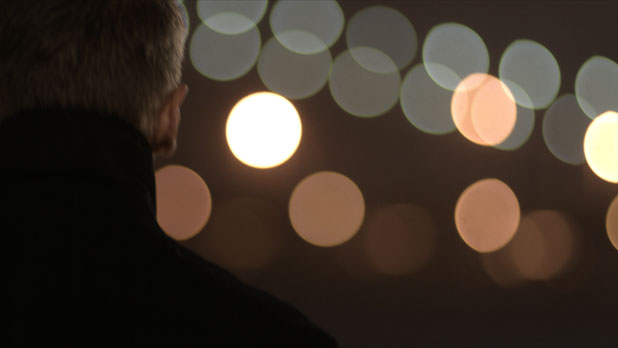
Same shot as above, but walking with Colin toward the bridge.
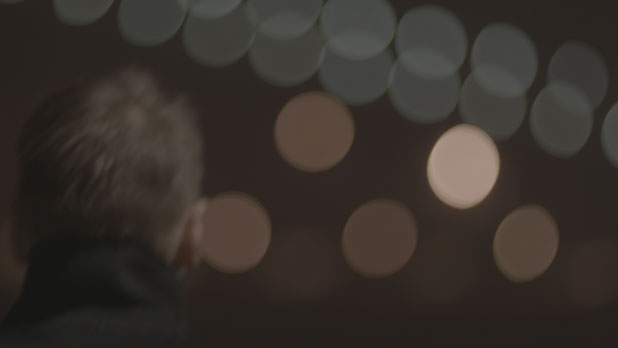
Same shot as above, ungraded LogC.
This shot generated some concern on the Cinematography Mailing List as a number of people assumed that they were seeing “jello-cam”: as the camera moves abruptly the out-of-focus lights in the background appear to smear and change shape, as one might expect with a rolling shutter. I stepped through these frames one by one and determined that the effect seen is not that of rolling shutter, but a combination of using a 270 degree shutter and cat’s eye vignetting:
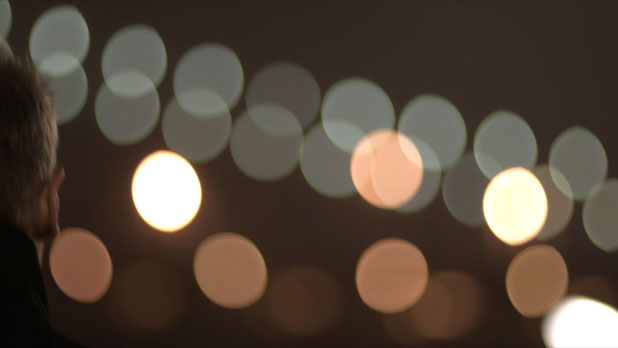
Figure 1: In the frame above we can see some motion blur from the 270 degree shutter, and a number of the lights are ovals instead of circles. The ovals are due to cat’s eye vignetting, where out-of-focus highlights near the edge of the frame are cut off by the aperture opening. Click here to read the best explanation I could find for this phenomenon. Keep an eye on the highlight toward the left of frame, next to Colin’s ear, as we’re going to watch what happens to it over the course of the shot.
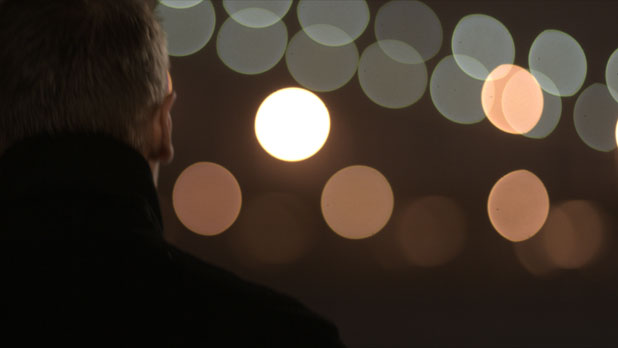
Figure 2: The above frame is relatively still and occurs during an abrupt change in camera direction. The motion blur from the 270 degree shutter is gone, and the bright highlight that was vignetted before is no longer cut off as it is now near the center of the frame, where the effect disappears.
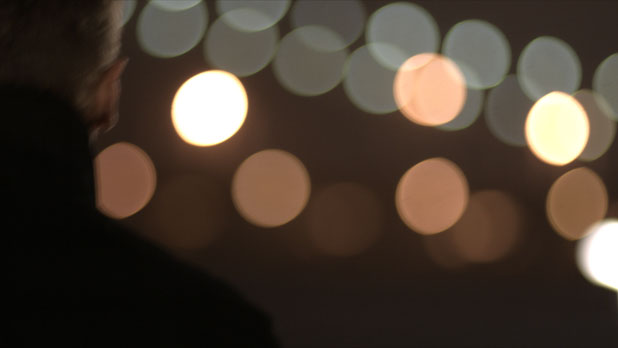
Figure 3: This time the bright highlight near Colin’s ear is shaped differently to the first one. It has resumed its cat’s eye shape by drifting left, away from the center of the lens, and the shape is oriented differently from the first image above because the highlight falls above the horizontal mid-point of the lens. In figure 1, above, the cat’s eye shape is different because it falls below the mid-point of the lens.
A line drawn through the short axis of these cat’s eyes passes through the center of the image. The cat’s eye vignette increases in strength the farther it gets from the center of the frame, and the short axis is always oriented toward the middle of the frame.
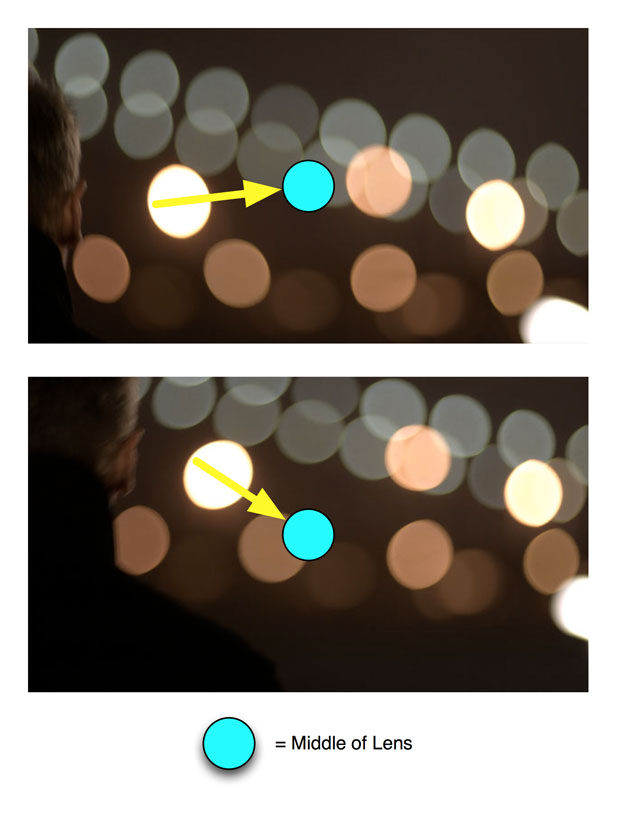
The arrows bisecting the cat’s eye don’t line up perfectly with the lens center but you can clearly see what’s going on. The combination of motion blur and the changing shape of the bokeh can give the impression of jello-cam but I see no evidence of rolling shutter artifacts whatsoever. The cat’s eye vignette is lens-dependent, and these old Zeiss Super Speed lenses appear to be the culprit. The vignette is easily removed by stopping down a few stops… which is not going to happen when shooting entirely by the light of existing street lamps. (The light on Colin read T1.4 incident when he was directly in front of one of the streetlights.)
If you’re curious as to why the shot was so bouncy, that’s because I was operating it like this:
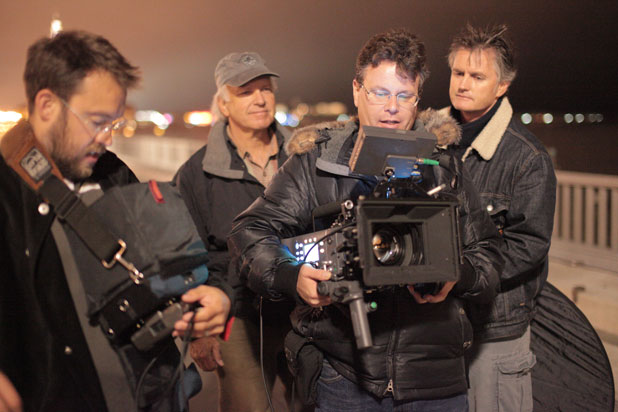
Left to right: Director Ian McCamey, camera assistant Paul Marbury, me, gaffer Simon Sommerfeld.
Let’s take a quick trip over to Treasure Island:
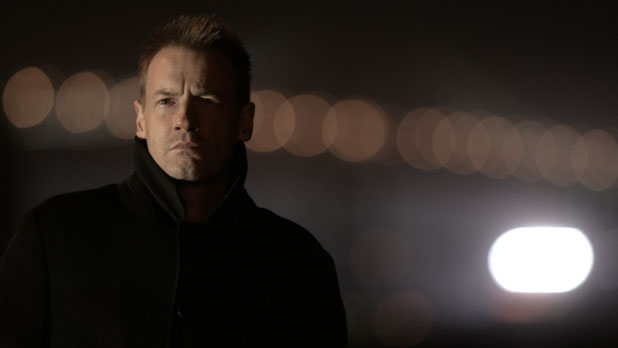
Colin in front of the Bay Bridge, on the edge of Treasure Island. Lens is the 200mm Nikkor T2, at T2. The “key” on Colin’s face is T2 incident.
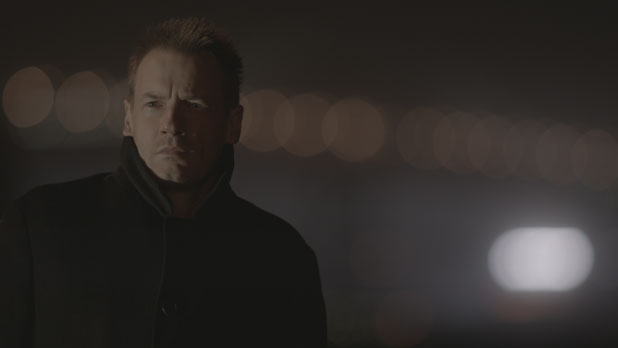
The same shot, ungraded, in LogC.
This was shot around 11:15pm on Treasure Island. We’d shot some scenics farther up the road as I was paranoid about moving near the guard shack that controls access to the rest of the island, but the light was better here and we needed to shoot past the end of a wall that threatened to obstruct our wide shot. We worked quickly and quietly so as not to wake the guard.
Here’s the wide version:
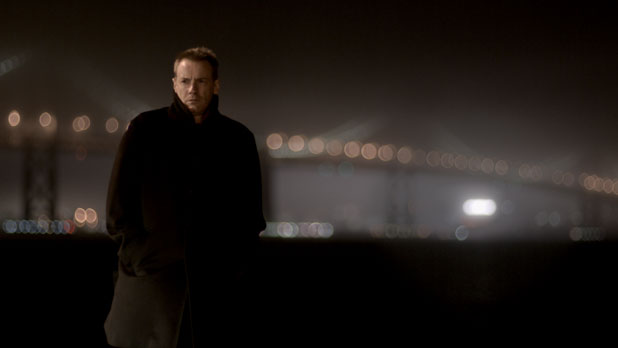
Wider shot, same location. Lens is an 85mm Super Speed at T1.3. 180 degree shutter. The “key” on Colin’s face is T1.4 incident.
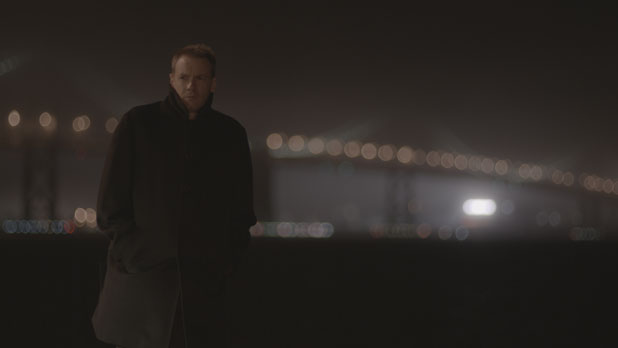
The same in LogC.
The bright light in the lower right of frame is the stadium lighting in AT&T Park. Apparently there was a game that night.
Here’s the extent of our lighting:
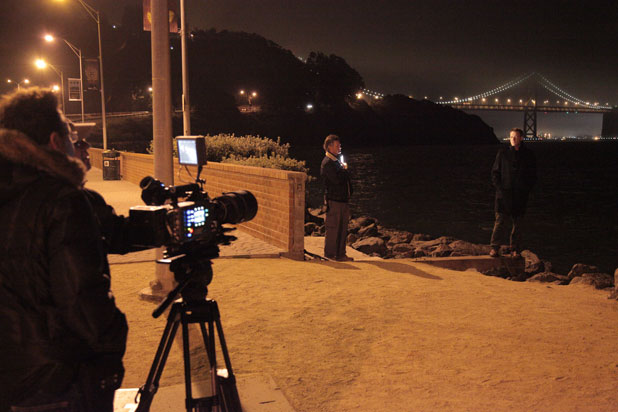
Simon Sommerfeld lights with the trusty LightPanel Micro.
Once again we’re following the direction of the ambient lighting, which is coming from a parking lot on camera left. The LightPanel Micro is making the bright side of Colin’s face a bit brighter to “pop” it a bit. If you’re curious about the fill level…
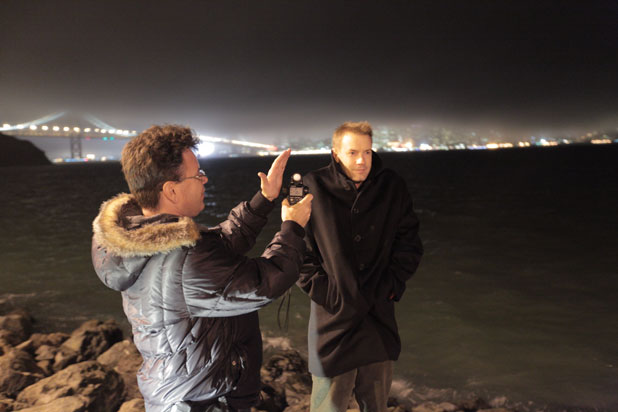
Me, reading the ambient fill level.
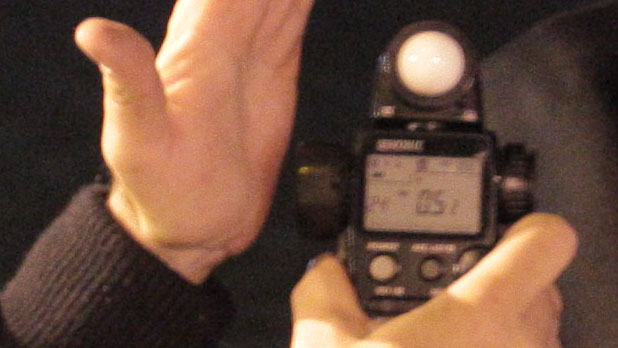
A blowup of the above, showing what my meter reads.
Yikes. Colin’s face almost looks flat-lit in the LogC version of the wider shot. It’s a little crisper on the close-up as that lens only opens up to T2 instead of T1.3, so the fill is a stop darker than it was on the wide shot. It’s amazing what one small light can do, especially if you’re using it to augment the lighting that’s already there. (We moved the Micro in on the close-up to build the “key” level from T1.4 to T2 incident.)
Once again, notice the cat’s eye vignetting on the highlights in the background near the left and right edges of frame.
More low-light goodness can be found on the next page…
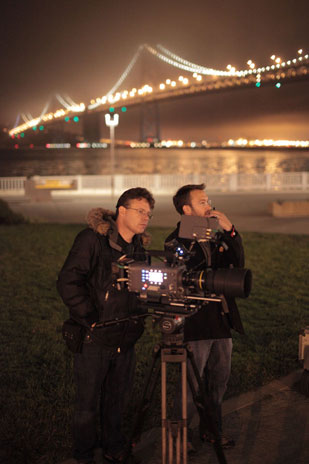
I watch the monitor as director Ian McCamey directs by radio, which is what you have to do when working with long lenses.
Welcome back to The Embarcadero. We’ll return to Treasure Island in a bit. Meanwhile, the following shot happened just a bit after sunset:
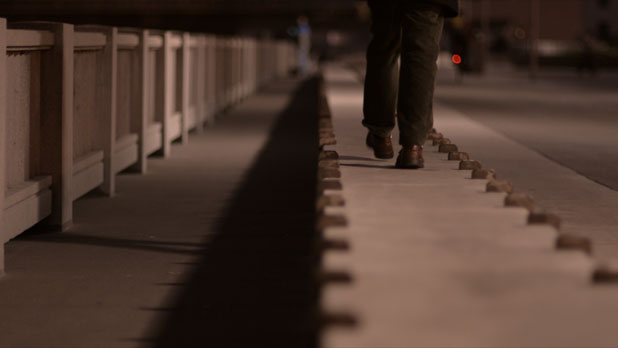
85mm Super Speed, T1.3, 180 degree shutter.
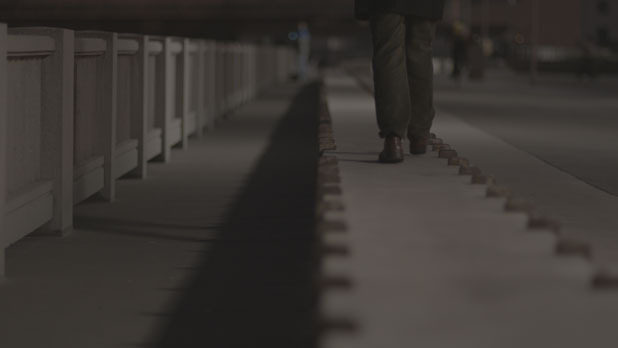
Same shot, LogC.
Look at all that shadow detail in the LogC image!
The following shot occurs later on in the edited montage but was shot around the same time:
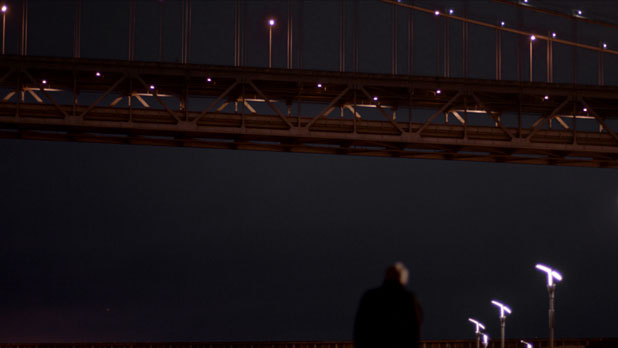
85mm Super Speed, T1.3, 180 degree shutter.
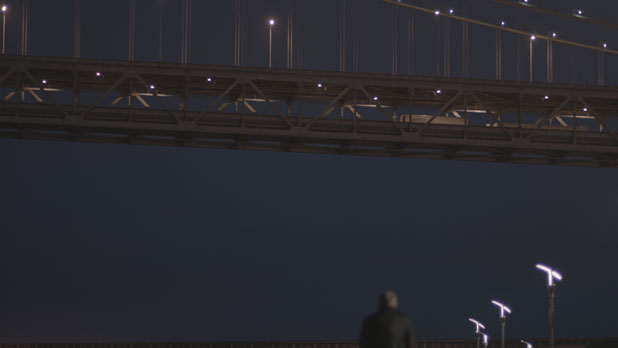
Same shot, LogC.
The only difference is that I kept tilting up to reveal the bridge in the latter shot to reveal some shapes that will be enhanced later. The lighting consists of sky “glow” combined with nearby street lights, some of which can be seen in the bottom right corner.
These shots will have symbolic significance in the final project. Right now I’ll just point out that the sky read T0.7 1/2 reflected at the time and we had to darken it and remove some of the blue in the grade to make it match the other shots. A digital grad was added to the top of the frame over the bridge.
We didn’t do anything really spectacular here other than to wedge a high-hat between the raised walkway and a lens case in order to get the lens where Ian wanted it-directly over the left edge of the walkway, to create a strong vertical line that runs into the distance.
Here’s a shot that we did shortly before Colin’s opening shot on the previous page:
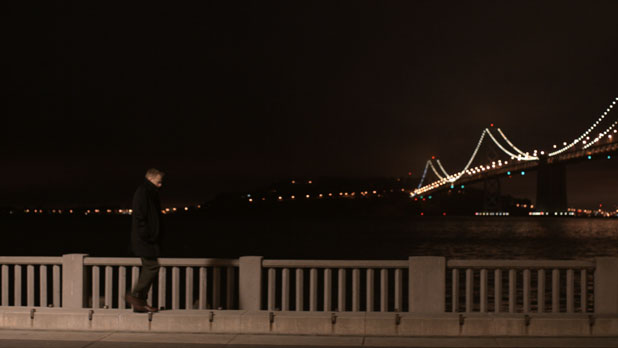
35mm Super Speed, T1.3, 180 degree shutter. All natural lighting.
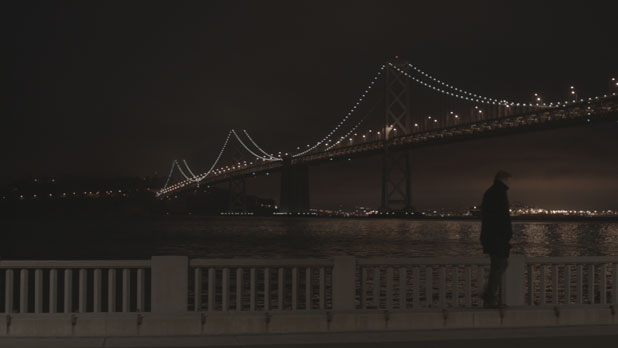
The same shot, LogC.
As I look through most of these shots I think to myself, “Well, not much to write about here. We placed the camera, set a T-stop, and shot. Nothing special.” And maybe that’s what is so special: we did remarkably little to get these shots. We moved quickly, sure-we had to complete all these shots, along with some additional shots not featured in this montage, in a few hours in high traffic areas without legal authority to do so-but we were able to get good results with a minimum of lighting/grip work.
That’s not to say that we should immediately eliminate our lighting and grip departments. Lighting people is relatively easy (once you know how to light faces, which is an art form and craft in itself) but they are only part of the equation; we always need a background to shoot them against, and backgrounds are often quite big. In a situation like this, where the background is the Bay Bridge, Treasure Island and The Port of Oakland, we can’t light it-but the Alexa gives us the ability to use the existing light to illuminate the deep background. We’ll still need to light the talent for mood and beauty, and we’ll need to light the immediate background for mood, but distant backgrounds that are self-illuminating can now add an additional layer of depth to a night exterior image.
Besides, there’s a difference between “illumination” and “lighting”: “illumination” means that there’s enough light for an exposure, but says nothing about the look; “lighting” creates moods and tells stories, and often doesn’t happen by accident but instead by careful planning and execution.
I do hope that this kind of lighting (or un-lighting) doesn’t become standard. Shooting at T1.3 is not a nice thing to do to camera assistants. I had an excellent one in Paul Marbury, but I’d hate to make him, or any camera assistant, pull focus wide open all the time. One should have mercy on one’s minions. I prefer not to shoot wider than T2.8 when possible as that gives focus pullers a fighting chance, and most lenses work better when stopped down a bit. These Super Speeds would have looked a lot sharper if we’d elected to shoot at a T2 instead of T1.3. (A good rule of thumb is that all lenses tend to look their best stopped about 2 1/3 stops down from wide open.)
The nice thing about shooting at EI 800 with the Alexa is that it only takes 12fc to get to that T-stop. So while you can shoot at T1.3 with (gulp!) 3fc of light, at that point you’re doing more damage control than anything else: it’s not about adding light at that point, although it’s probably a good idea; it’s more about getting rid of stray sources that do ugly things to your actors. You never know when a car will turn the corner a half mile away and completely change the modeling on your leading lady’s face.
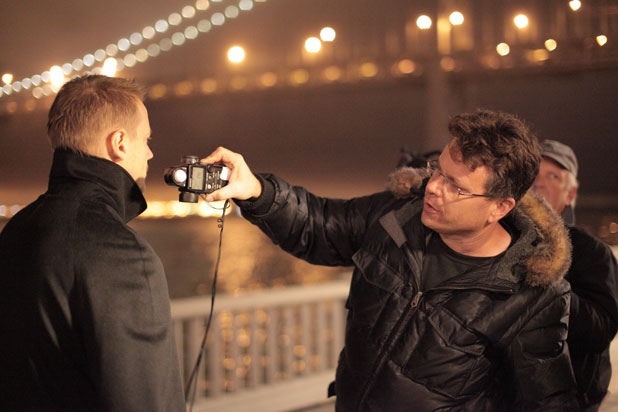
How lucky: a meter reading near Colin’s face says T1.4, and I have a lens that will do that!
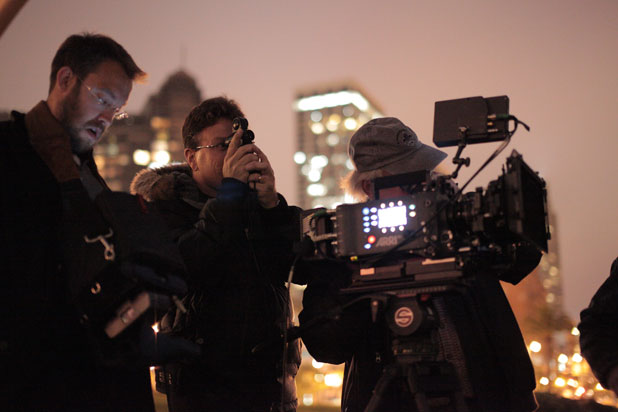
Preparing to shoot Colin walking in front of the bridge. While Ian directs from his monitor and Paul gets focus marks, I take a light reading off the fog cover that’s lit by the Port of Oakland lights on the other side of the bay. It was quite lucky for us that we had that brightly-lit foggy background; otherwise the bridge would have appeared as a dark blob in most of the shots.
The following shot was the one that gave us fits as we had to wait for trains and hope not to be blocked by a crowd of pedestrians:
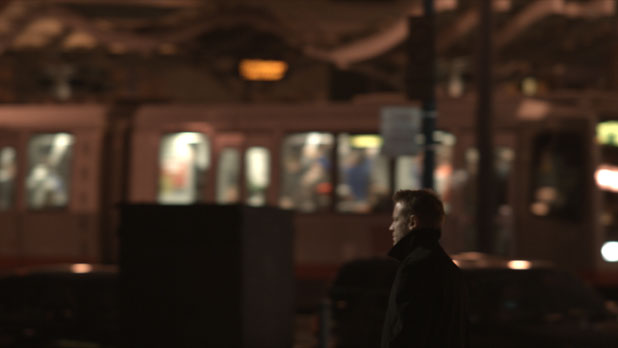
200mm Nikkor at T2, 270 degree shutter. The dark parts of the train read T1.05, and the background highlights read T1.4 1/2.
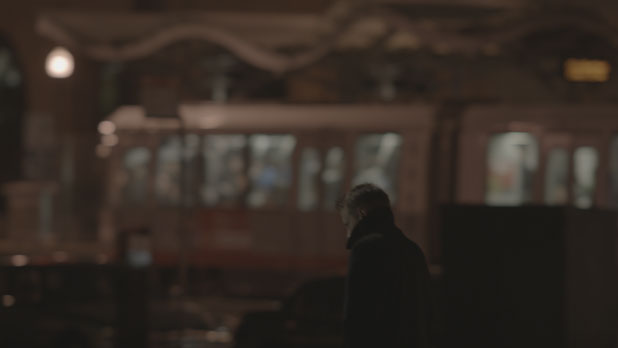
The same shot in LogC.
The light on Colin’s face is-yup, you guessed it-a LightPanel Micro held by gaffer Simon Sommerfeld off frame left. Colin started his walk about 25′ away from Simon and exited frame with about 10′ to go. I never thought an LED light would make such a difference over a long distance, but it did.
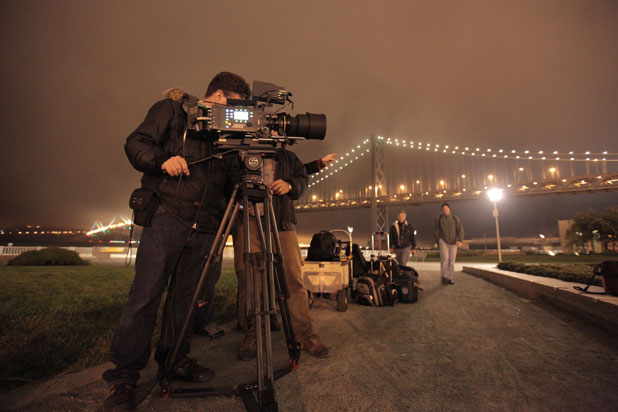
Shooting the train shot from atop a (not so grassy) knoll.
The following shot was a test of the Alexa’s ergonomics:
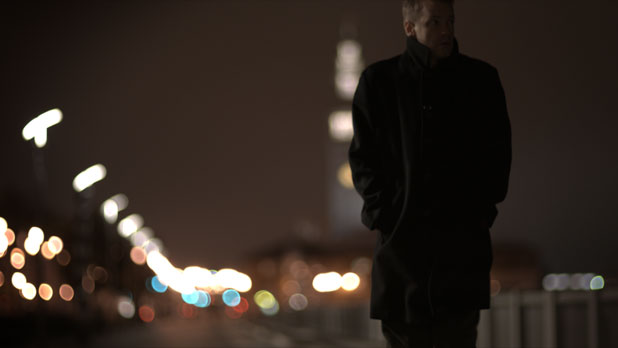
85mm Super Speed, T1.3, 180 degree shutter, pulling my own focus. Colin’s face was T1.4 when directly in front of a streetlight.
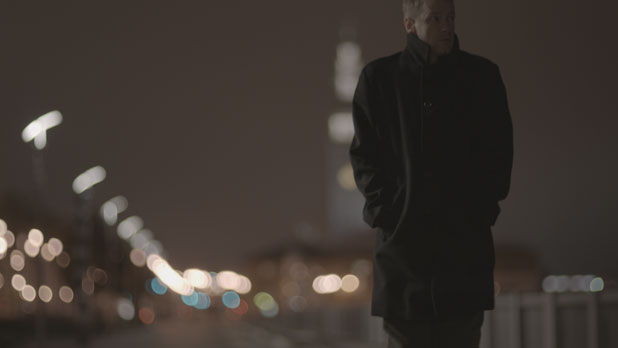
Same shot, LogC.
Look how much detail there is in the LogC image! I didn’t bother metering that as it was what it was, and I never thought I’d see so much shadow detail. This is the dead of night, with the light coming predominantly from the row of streetlights on the left of frame.
The Alexa’s ergonomics were fine: the camera has a nice little notch for handheld use and it’s surprisingly well balanced for a camera that looks like a large brick. A few more sit-ups per day and this shot would have been a bit steadier, but overall it did what Ian wanted.
The following shot was a LOT of fun:
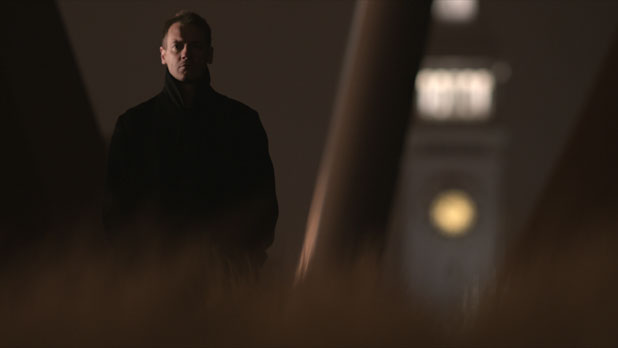
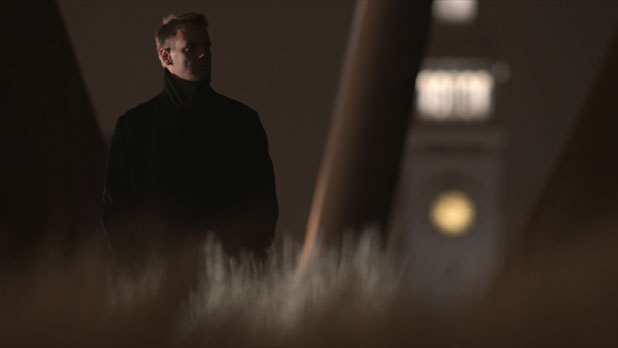
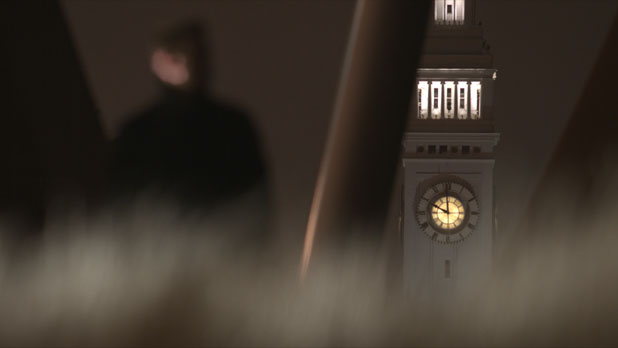
200mm Nikkor, T2, 180 degree shutter.
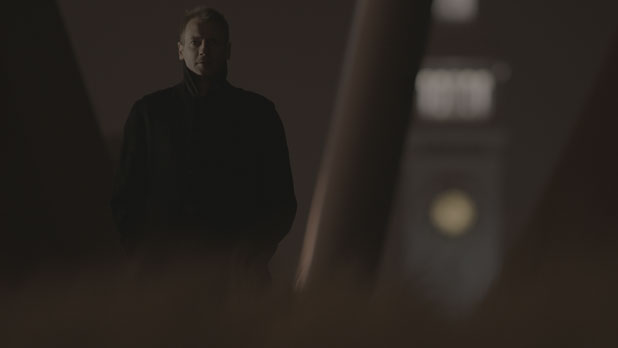
Same shot, LogC.
The main light, as always, was a LightPanel Micro, held this time by production assistant Jim Feeley. Gaffer Simon Sommerfeld was sixty feet behind and to the left of Colin holding a flashlight I’d bought for $10 earlier that day. During the shot he swept it through the grass, to great effect.
Just for fun I took a spot reading of the grass in its lit and unlit states. My notes say that unlit read T0.5 and lit read T0.7. It’s hard to believe we were able to pull such detail out of the murk of underexposure.
And now, back to Treasure Island:
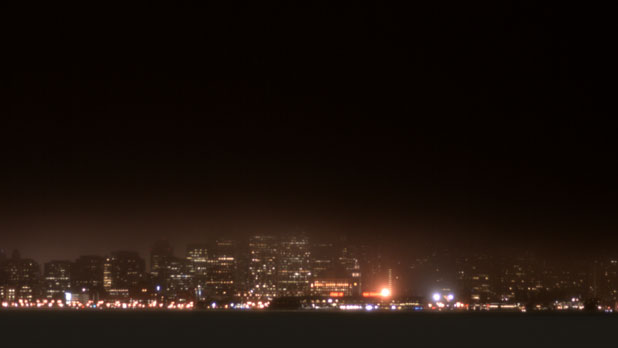
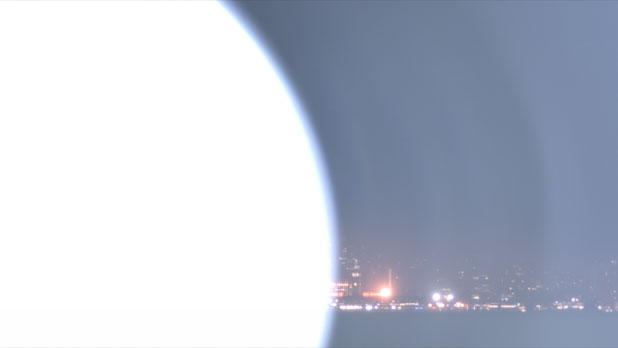
200mm Nikkor, T2, 270 degree shutter.
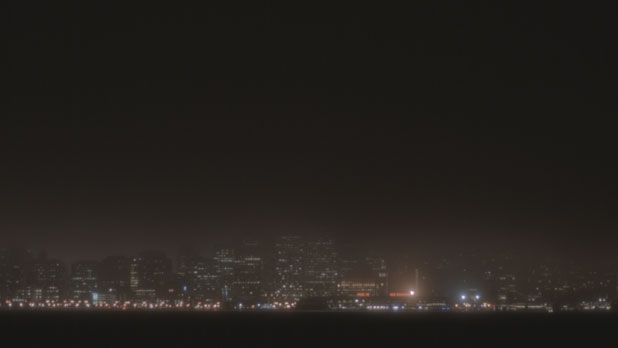
The same, LogC.
While setting up for a vista of San Francisco Ian noticed Paul cleaning water droplets from the lens and checking his work with a flashlight. He thought it was cool, so we shot it.
While it looks like we may have used a grad or a power window at the top of frame to darken the sky, we didn’t. That’s fog. Welcome to San Francisco in August.
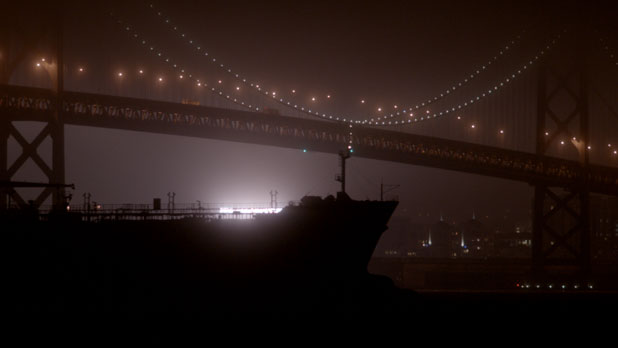
200mm Nikkor, T2, 270 degree shutter.
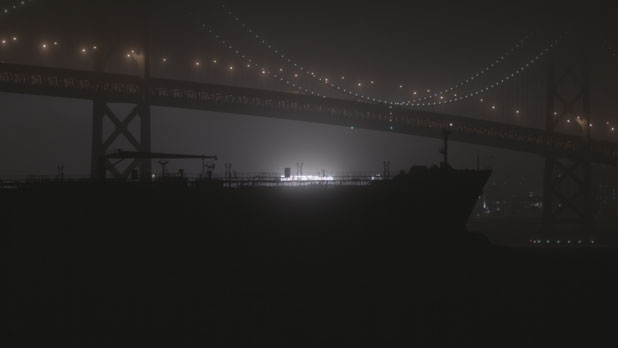
The same, LogC.
Camera assistant Paul Marbury was grabbing a focus mark on the bridge in preparation for a shot of Colin when I heard him exclaim something along the lines of “Holy crap!” We turned around and saw this ship moving under the Bay Bridge, beautifully backlit by the lights from AT&T Park. Ian’s one comment: “I hope we’re rolling.” We were. Paul hit the roll button very, very quickly. (We punched in on this shot in post as someone didn’t know we were rolling and stepped into frame left.)
And that’s about it for our adventure. Ian spent a couple of hours the next morning doing a rough cut and we graded it immediately before projecting it for the first time. Ian is the in process of re-editing and adding some visual effects, at which point I look forward to showing you what this was really meant to be.
I asked Ian for a comment about workflow, as he cut the piece and has a background as a visual effects editor at The Orphanage. He had this to say:
“Aside from producing amazing low-light images that feel genuinely ‘filmic,’ the post pipeline was a dream. I typically cut my own stuff, so being able to start cutting with the files that came directly from the camera without any transcoding was fantastic. And having access to the LogC content for grading-it’s just a simple workflow. Finally someone in the camera world got it right!” -Ian McCamey, director/editor
ARRI Alexa San Francisco Demo Footage Shoot
A Digital Cinema Society co-production
Director: Ian McCamey
DP: Art Adams
Gaffer: Simon Sommerfeld, DCS Northern Calfornia President
Camera Assistant: Paul Marbury
Production Assistant: Jim Feeley
Behind-the-Scenes Stills: Adam WiltTalent: Colin Stuart
Production Support: Leigh Blicher, Videofax
Prototype Alexa Camera courtesy of ARRI and Michael Bravin
Join the ARRI Alexa community at ARRI DigitalGrading by Shane Mario Ruggieri
Scratch system by Lucas Wilson/AssimilateShot entirely on location in San Francisco without anyone’s knowledge or permission
Art Adams is a director of photography who is not afraid of the dark. His website is at www.artadams.net.

Filmtools
Filmmakers go-to destination for pre-production, production & post production equipment!
Shop Now